Business Communication Report: Tesco's Information and Strategies
VerifiedAdded on 2023/03/30
|13
|2783
|460
Report
AI Summary
This report delves into the multifaceted world of business communication, examining various types of information, their sources, and intended purposes. It provides a detailed analysis of Tesco's internal and external communication strategies, including mission statements, objectives, and corporate communications such as leaflets and advertisements. The report explores different communication methods, encompassing verbal, written, and on-screen information, and analyzes the legal and ethical considerations, such as the Data Protection Act and the Freedom of Information Act, that govern the use of business information. Furthermore, it addresses operational issues related to information management, including security, backups, and organizational policies. The report emphasizes the importance of effective communication in influencing actions and achieving organizational objectives, making it a valuable resource for understanding the complexities of business communication within a real-world context.
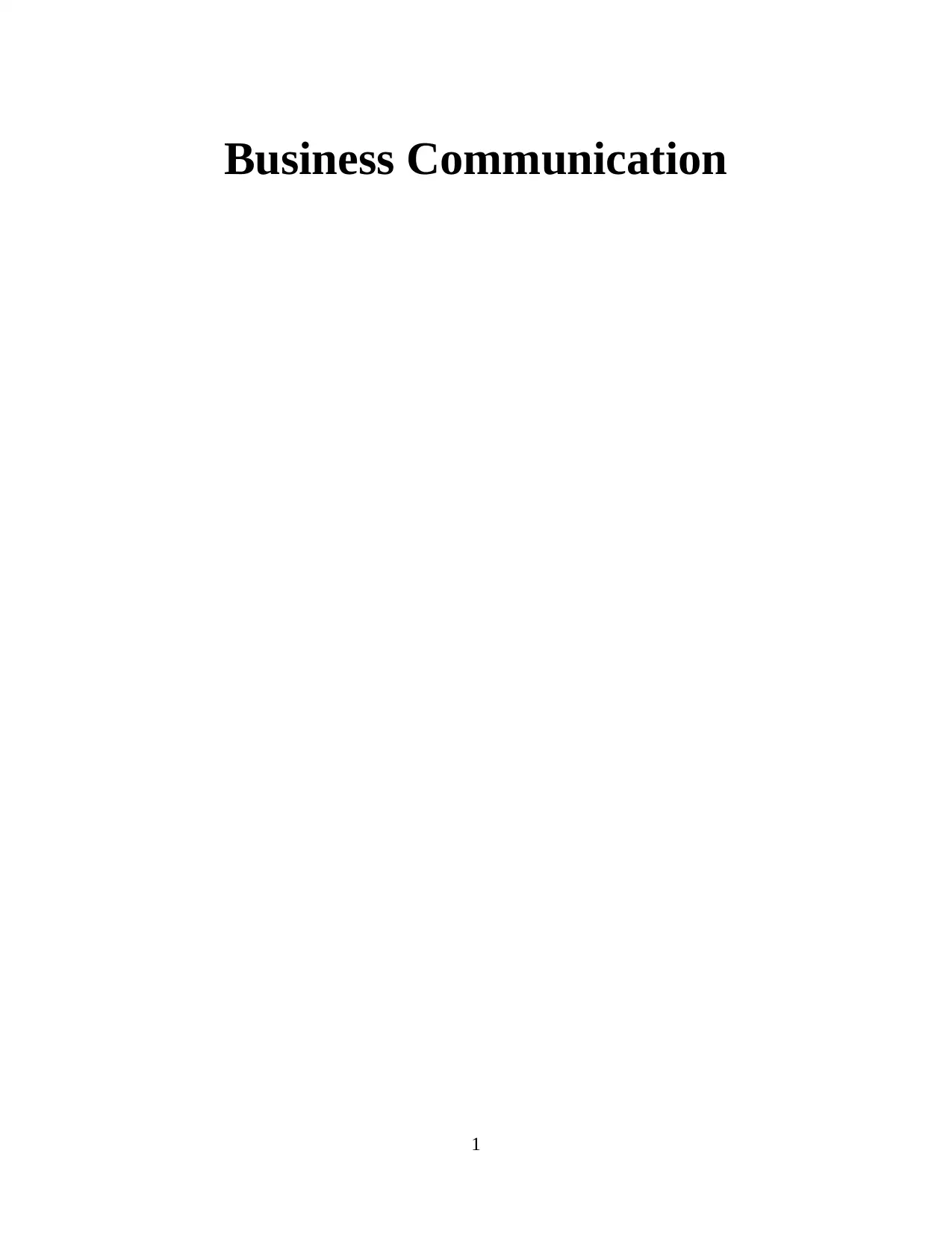
Business Communication
1
1
Paraphrase This Document
Need a fresh take? Get an instant paraphrase of this document with our AI Paraphraser
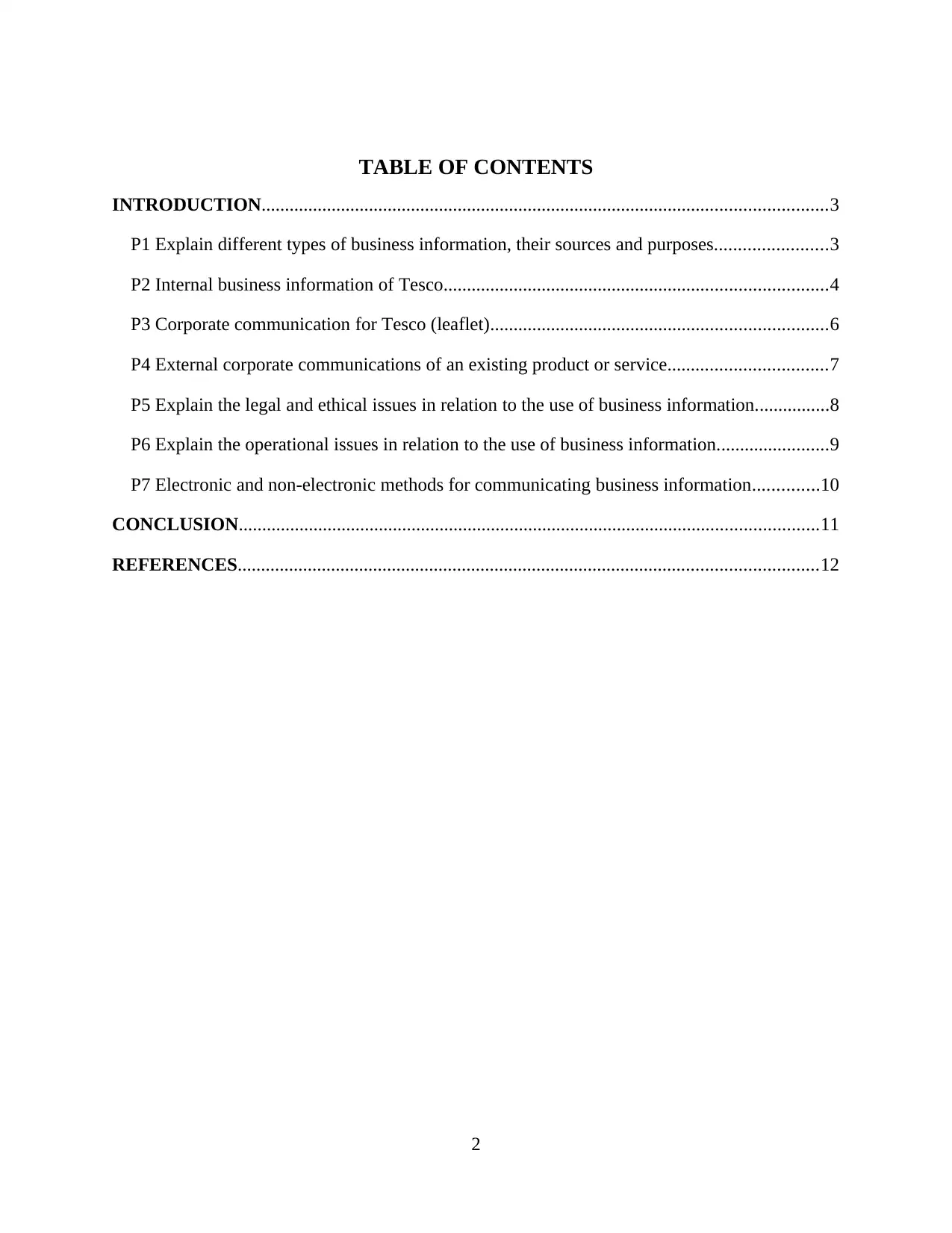
TABLE OF CONTENTS
INTRODUCTION.........................................................................................................................3
P1 Explain different types of business information, their sources and purposes........................3
P2 Internal business information of Tesco..................................................................................4
P3 Corporate communication for Tesco (leaflet)........................................................................6
P4 External corporate communications of an existing product or service..................................7
P5 Explain the legal and ethical issues in relation to the use of business information................8
P6 Explain the operational issues in relation to the use of business information........................9
P7 Electronic and non-electronic methods for communicating business information..............10
CONCLUSION............................................................................................................................11
REFERENCES............................................................................................................................12
2
INTRODUCTION.........................................................................................................................3
P1 Explain different types of business information, their sources and purposes........................3
P2 Internal business information of Tesco..................................................................................4
P3 Corporate communication for Tesco (leaflet)........................................................................6
P4 External corporate communications of an existing product or service..................................7
P5 Explain the legal and ethical issues in relation to the use of business information................8
P6 Explain the operational issues in relation to the use of business information........................9
P7 Electronic and non-electronic methods for communicating business information..............10
CONCLUSION............................................................................................................................11
REFERENCES............................................................................................................................12
2
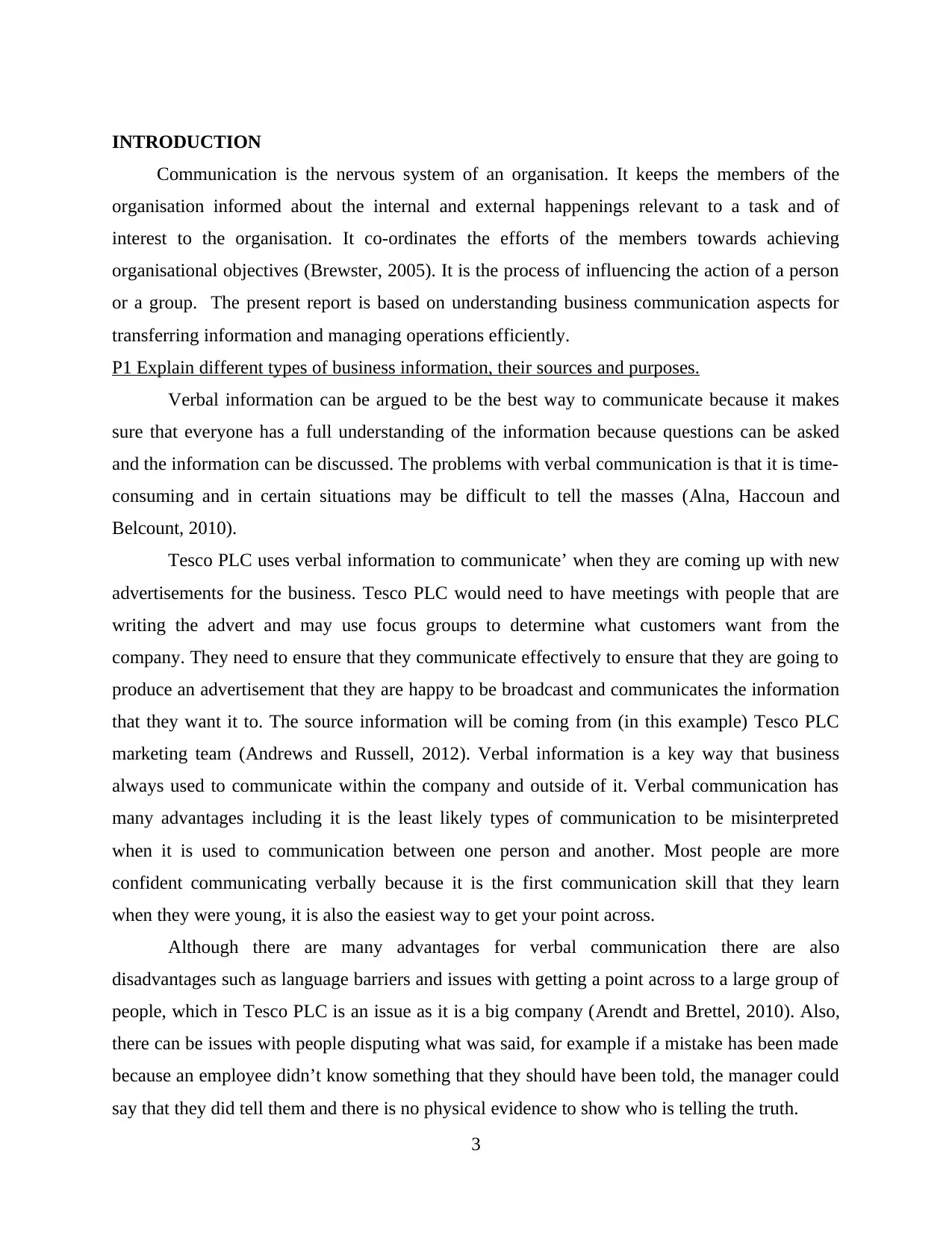
INTRODUCTION
Communication is the nervous system of an organisation. It keeps the members of the
organisation informed about the internal and external happenings relevant to a task and of
interest to the organisation. It co-ordinates the efforts of the members towards achieving
organisational objectives (Brewster, 2005). It is the process of influencing the action of a person
or a group. The present report is based on understanding business communication aspects for
transferring information and managing operations efficiently.
P1 Explain different types of business information, their sources and purposes.
Verbal information can be argued to be the best way to communicate because it makes
sure that everyone has a full understanding of the information because questions can be asked
and the information can be discussed. The problems with verbal communication is that it is time-
consuming and in certain situations may be difficult to tell the masses (Alna, Haccoun and
Belcount, 2010).
Tesco PLC uses verbal information to communicate’ when they are coming up with new
advertisements for the business. Tesco PLC would need to have meetings with people that are
writing the advert and may use focus groups to determine what customers want from the
company. They need to ensure that they communicate effectively to ensure that they are going to
produce an advertisement that they are happy to be broadcast and communicates the information
that they want it to. The source information will be coming from (in this example) Tesco PLC
marketing team (Andrews and Russell, 2012). Verbal information is a key way that business
always used to communicate within the company and outside of it. Verbal communication has
many advantages including it is the least likely types of communication to be misinterpreted
when it is used to communication between one person and another. Most people are more
confident communicating verbally because it is the first communication skill that they learn
when they were young, it is also the easiest way to get your point across.
Although there are many advantages for verbal communication there are also
disadvantages such as language barriers and issues with getting a point across to a large group of
people, which in Tesco PLC is an issue as it is a big company (Arendt and Brettel, 2010). Also,
there can be issues with people disputing what was said, for example if a mistake has been made
because an employee didn’t know something that they should have been told, the manager could
say that they did tell them and there is no physical evidence to show who is telling the truth.
3
Communication is the nervous system of an organisation. It keeps the members of the
organisation informed about the internal and external happenings relevant to a task and of
interest to the organisation. It co-ordinates the efforts of the members towards achieving
organisational objectives (Brewster, 2005). It is the process of influencing the action of a person
or a group. The present report is based on understanding business communication aspects for
transferring information and managing operations efficiently.
P1 Explain different types of business information, their sources and purposes.
Verbal information can be argued to be the best way to communicate because it makes
sure that everyone has a full understanding of the information because questions can be asked
and the information can be discussed. The problems with verbal communication is that it is time-
consuming and in certain situations may be difficult to tell the masses (Alna, Haccoun and
Belcount, 2010).
Tesco PLC uses verbal information to communicate’ when they are coming up with new
advertisements for the business. Tesco PLC would need to have meetings with people that are
writing the advert and may use focus groups to determine what customers want from the
company. They need to ensure that they communicate effectively to ensure that they are going to
produce an advertisement that they are happy to be broadcast and communicates the information
that they want it to. The source information will be coming from (in this example) Tesco PLC
marketing team (Andrews and Russell, 2012). Verbal information is a key way that business
always used to communicate within the company and outside of it. Verbal communication has
many advantages including it is the least likely types of communication to be misinterpreted
when it is used to communication between one person and another. Most people are more
confident communicating verbally because it is the first communication skill that they learn
when they were young, it is also the easiest way to get your point across.
Although there are many advantages for verbal communication there are also
disadvantages such as language barriers and issues with getting a point across to a large group of
people, which in Tesco PLC is an issue as it is a big company (Arendt and Brettel, 2010). Also,
there can be issues with people disputing what was said, for example if a mistake has been made
because an employee didn’t know something that they should have been told, the manager could
say that they did tell them and there is no physical evidence to show who is telling the truth.
3
⊘ This is a preview!⊘
Do you want full access?
Subscribe today to unlock all pages.

Trusted by 1+ million students worldwide
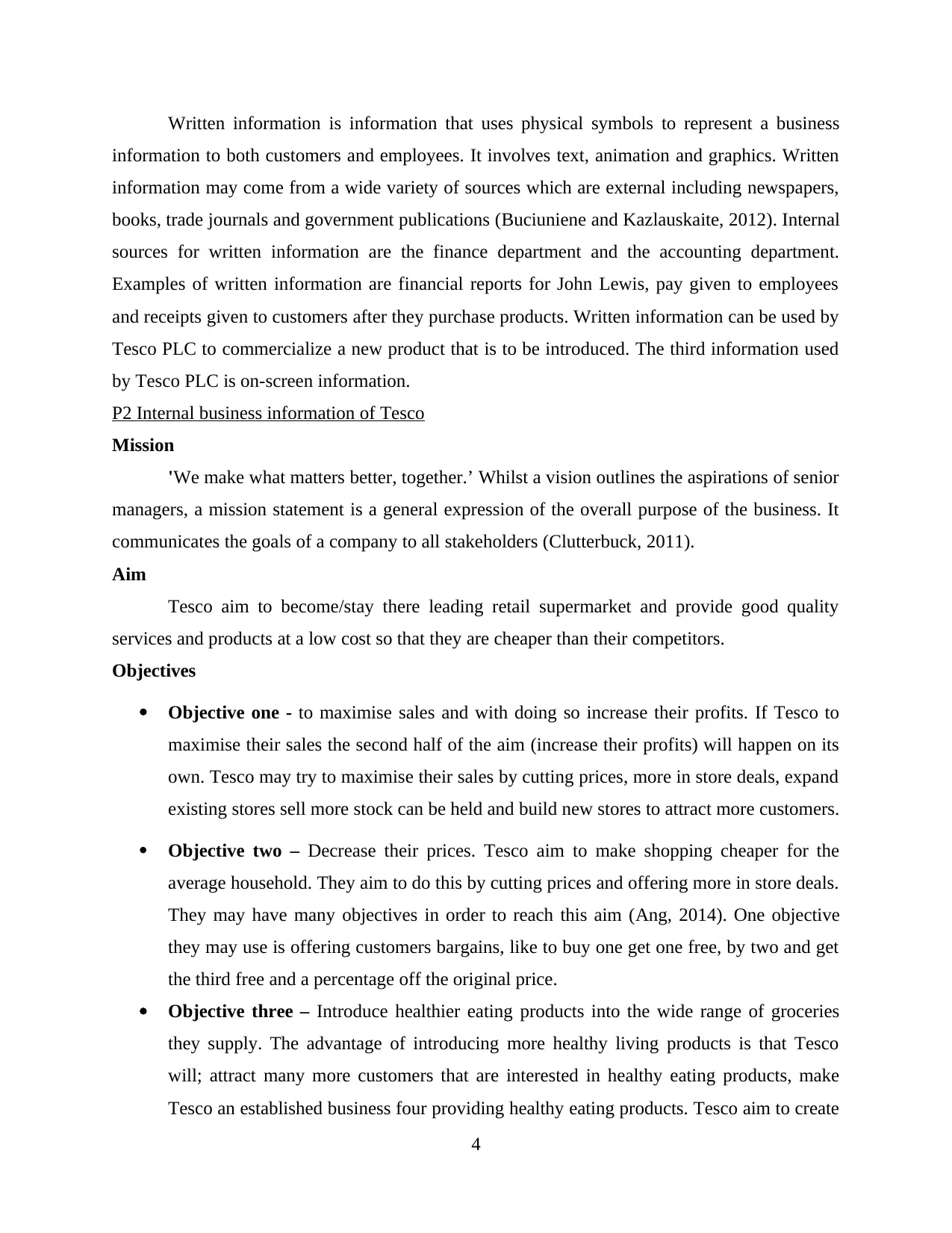
Written information is information that uses physical symbols to represent a business
information to both customers and employees. It involves text, animation and graphics. Written
information may come from a wide variety of sources which are external including newspapers,
books, trade journals and government publications (Buciuniene and Kazlauskaite, 2012). Internal
sources for written information are the finance department and the accounting department.
Examples of written information are financial reports for John Lewis, pay given to employees
and receipts given to customers after they purchase products. Written information can be used by
Tesco PLC to commercialize a new product that is to be introduced. The third information used
by Tesco PLC is on-screen information.
P2 Internal business information of Tesco
Mission
'We make what matters better, together.’ Whilst a vision outlines the aspirations of senior
managers, a mission statement is a general expression of the overall purpose of the business. It
communicates the goals of a company to all stakeholders (Clutterbuck, 2011).
Aim
Tesco aim to become/stay there leading retail supermarket and provide good quality
services and products at a low cost so that they are cheaper than their competitors.
Objectives
Objective one - to maximise sales and with doing so increase their profits. If Tesco to
maximise their sales the second half of the aim (increase their profits) will happen on its
own. Tesco may try to maximise their sales by cutting prices, more in store deals, expand
existing stores sell more stock can be held and build new stores to attract more customers.
Objective two – Decrease their prices. Tesco aim to make shopping cheaper for the
average household. They aim to do this by cutting prices and offering more in store deals.
They may have many objectives in order to reach this aim (Ang, 2014). One objective
they may use is offering customers bargains, like to buy one get one free, by two and get
the third free and a percentage off the original price.
Objective three – Introduce healthier eating products into the wide range of groceries
they supply. The advantage of introducing more healthy living products is that Tesco
will; attract many more customers that are interested in healthy eating products, make
Tesco an established business four providing healthy eating products. Tesco aim to create
4
information to both customers and employees. It involves text, animation and graphics. Written
information may come from a wide variety of sources which are external including newspapers,
books, trade journals and government publications (Buciuniene and Kazlauskaite, 2012). Internal
sources for written information are the finance department and the accounting department.
Examples of written information are financial reports for John Lewis, pay given to employees
and receipts given to customers after they purchase products. Written information can be used by
Tesco PLC to commercialize a new product that is to be introduced. The third information used
by Tesco PLC is on-screen information.
P2 Internal business information of Tesco
Mission
'We make what matters better, together.’ Whilst a vision outlines the aspirations of senior
managers, a mission statement is a general expression of the overall purpose of the business. It
communicates the goals of a company to all stakeholders (Clutterbuck, 2011).
Aim
Tesco aim to become/stay there leading retail supermarket and provide good quality
services and products at a low cost so that they are cheaper than their competitors.
Objectives
Objective one - to maximise sales and with doing so increase their profits. If Tesco to
maximise their sales the second half of the aim (increase their profits) will happen on its
own. Tesco may try to maximise their sales by cutting prices, more in store deals, expand
existing stores sell more stock can be held and build new stores to attract more customers.
Objective two – Decrease their prices. Tesco aim to make shopping cheaper for the
average household. They aim to do this by cutting prices and offering more in store deals.
They may have many objectives in order to reach this aim (Ang, 2014). One objective
they may use is offering customers bargains, like to buy one get one free, by two and get
the third free and a percentage off the original price.
Objective three – Introduce healthier eating products into the wide range of groceries
they supply. The advantage of introducing more healthy living products is that Tesco
will; attract many more customers that are interested in healthy eating products, make
Tesco an established business four providing healthy eating products. Tesco aim to create
4
Paraphrase This Document
Need a fresh take? Get an instant paraphrase of this document with our AI Paraphraser
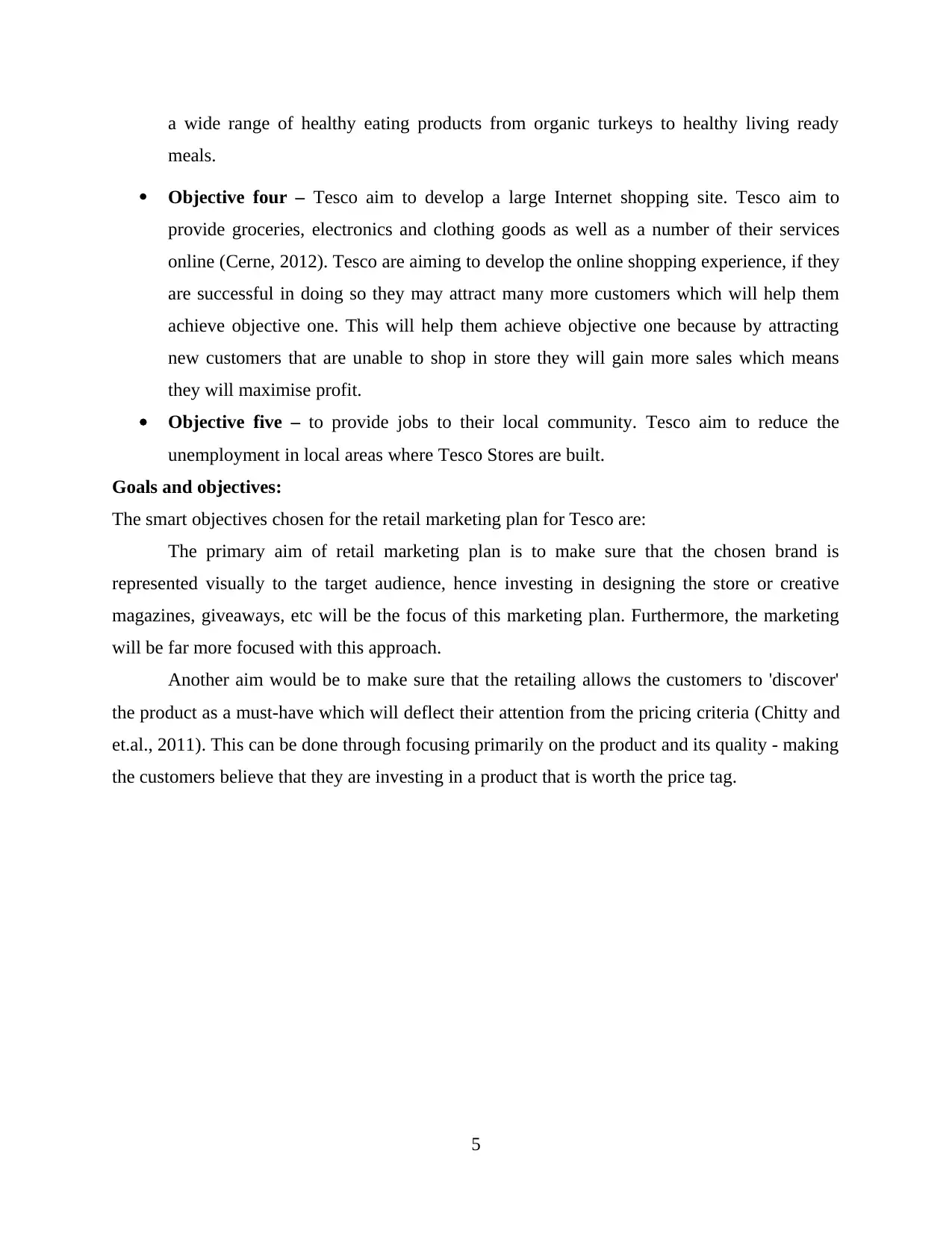
a wide range of healthy eating products from organic turkeys to healthy living ready
meals.
Objective four – Tesco aim to develop a large Internet shopping site. Tesco aim to
provide groceries, electronics and clothing goods as well as a number of their services
online (Cerne, 2012). Tesco are aiming to develop the online shopping experience, if they
are successful in doing so they may attract many more customers which will help them
achieve objective one. This will help them achieve objective one because by attracting
new customers that are unable to shop in store they will gain more sales which means
they will maximise profit.
Objective five – to provide jobs to their local community. Tesco aim to reduce the
unemployment in local areas where Tesco Stores are built.
Goals and objectives:
The smart objectives chosen for the retail marketing plan for Tesco are:
The primary aim of retail marketing plan is to make sure that the chosen brand is
represented visually to the target audience, hence investing in designing the store or creative
magazines, giveaways, etc will be the focus of this marketing plan. Furthermore, the marketing
will be far more focused with this approach.
Another aim would be to make sure that the retailing allows the customers to 'discover'
the product as a must-have which will deflect their attention from the pricing criteria (Chitty and
et.al., 2011). This can be done through focusing primarily on the product and its quality - making
the customers believe that they are investing in a product that is worth the price tag.
5
meals.
Objective four – Tesco aim to develop a large Internet shopping site. Tesco aim to
provide groceries, electronics and clothing goods as well as a number of their services
online (Cerne, 2012). Tesco are aiming to develop the online shopping experience, if they
are successful in doing so they may attract many more customers which will help them
achieve objective one. This will help them achieve objective one because by attracting
new customers that are unable to shop in store they will gain more sales which means
they will maximise profit.
Objective five – to provide jobs to their local community. Tesco aim to reduce the
unemployment in local areas where Tesco Stores are built.
Goals and objectives:
The smart objectives chosen for the retail marketing plan for Tesco are:
The primary aim of retail marketing plan is to make sure that the chosen brand is
represented visually to the target audience, hence investing in designing the store or creative
magazines, giveaways, etc will be the focus of this marketing plan. Furthermore, the marketing
will be far more focused with this approach.
Another aim would be to make sure that the retailing allows the customers to 'discover'
the product as a must-have which will deflect their attention from the pricing criteria (Chitty and
et.al., 2011). This can be done through focusing primarily on the product and its quality - making
the customers believe that they are investing in a product that is worth the price tag.
5
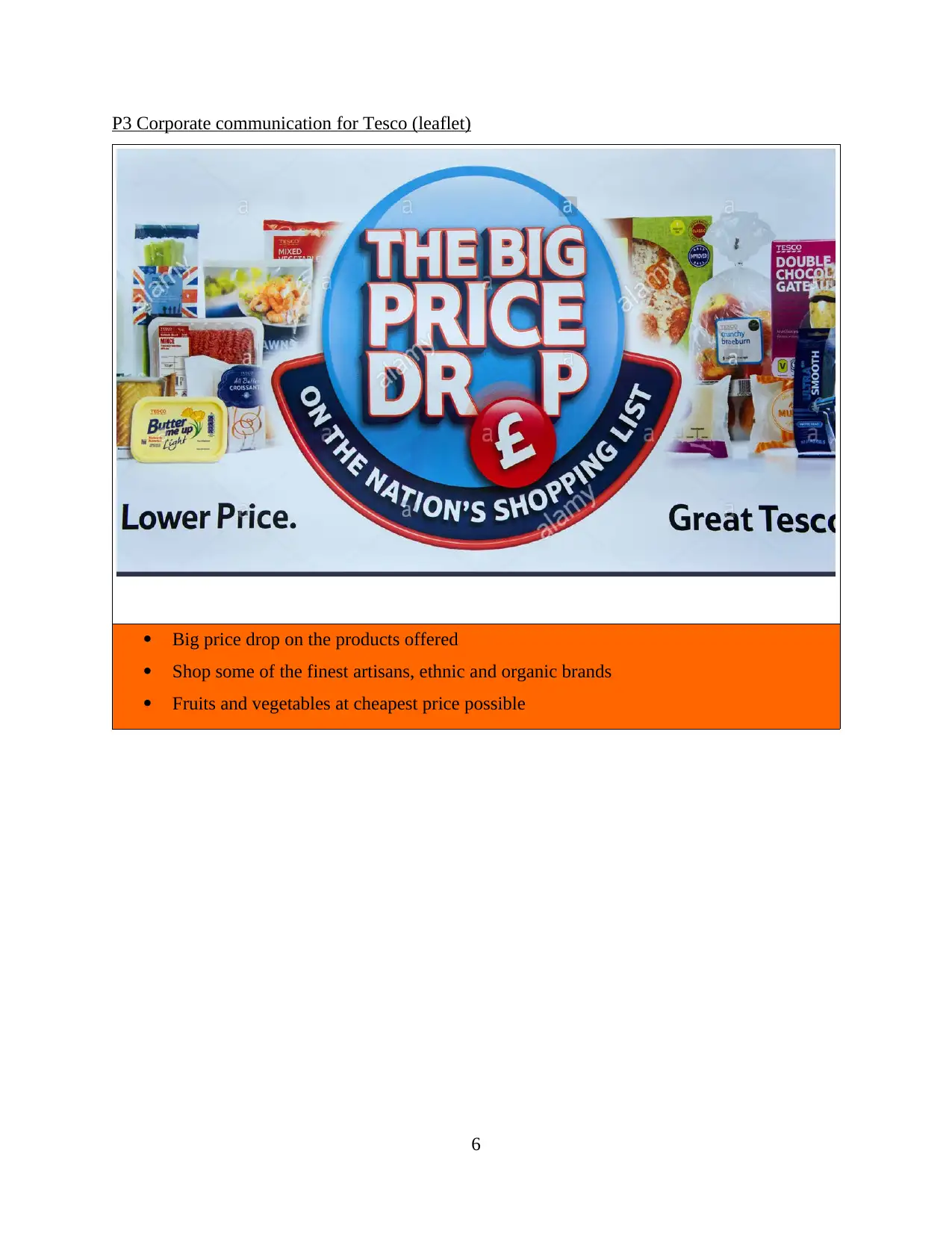
P3 Corporate communication for Tesco (leaflet)
Big price drop on the products offered
Shop some of the finest artisans, ethnic and organic brands
Fruits and vegetables at cheapest price possible
6
Big price drop on the products offered
Shop some of the finest artisans, ethnic and organic brands
Fruits and vegetables at cheapest price possible
6
⊘ This is a preview!⊘
Do you want full access?
Subscribe today to unlock all pages.

Trusted by 1+ million students worldwide
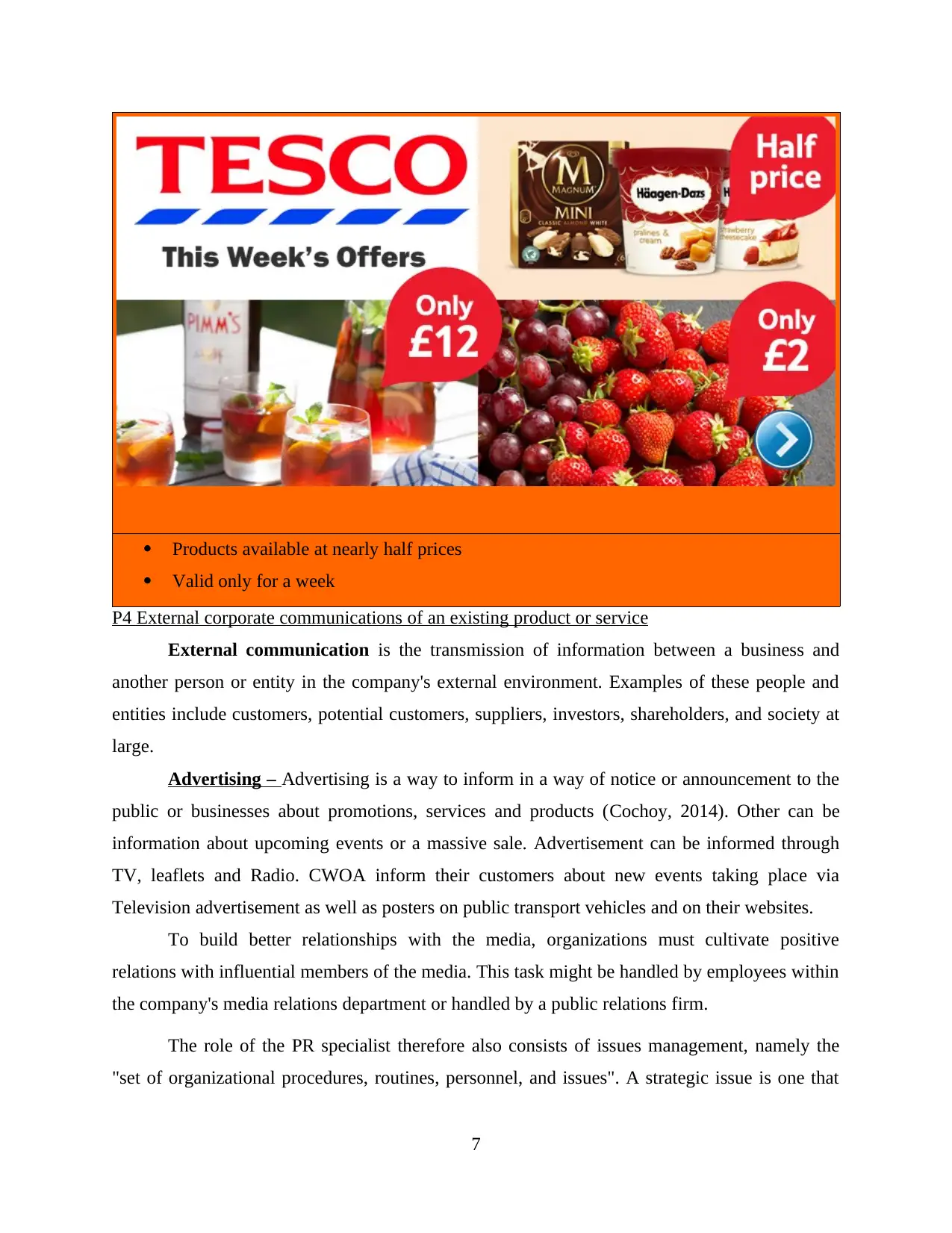
Products available at nearly half prices
Valid only for a week
P4 External corporate communications of an existing product or service
External communication is the transmission of information between a business and
another person or entity in the company's external environment. Examples of these people and
entities include customers, potential customers, suppliers, investors, shareholders, and society at
large.
Advertising – Advertising is a way to inform in a way of notice or announcement to the
public or businesses about promotions, services and products (Cochoy, 2014). Other can be
information about upcoming events or a massive sale. Advertisement can be informed through
TV, leaflets and Radio. CWOA inform their customers about new events taking place via
Television advertisement as well as posters on public transport vehicles and on their websites.
To build better relationships with the media, organizations must cultivate positive
relations with influential members of the media. This task might be handled by employees within
the company's media relations department or handled by a public relations firm.
The role of the PR specialist therefore also consists of issues management, namely the
"set of organizational procedures, routines, personnel, and issues". A strategic issue is one that
7
Valid only for a week
P4 External corporate communications of an existing product or service
External communication is the transmission of information between a business and
another person or entity in the company's external environment. Examples of these people and
entities include customers, potential customers, suppliers, investors, shareholders, and society at
large.
Advertising – Advertising is a way to inform in a way of notice or announcement to the
public or businesses about promotions, services and products (Cochoy, 2014). Other can be
information about upcoming events or a massive sale. Advertisement can be informed through
TV, leaflets and Radio. CWOA inform their customers about new events taking place via
Television advertisement as well as posters on public transport vehicles and on their websites.
To build better relationships with the media, organizations must cultivate positive
relations with influential members of the media. This task might be handled by employees within
the company's media relations department or handled by a public relations firm.
The role of the PR specialist therefore also consists of issues management, namely the
"set of organizational procedures, routines, personnel, and issues". A strategic issue is one that
7
Paraphrase This Document
Need a fresh take? Get an instant paraphrase of this document with our AI Paraphraser
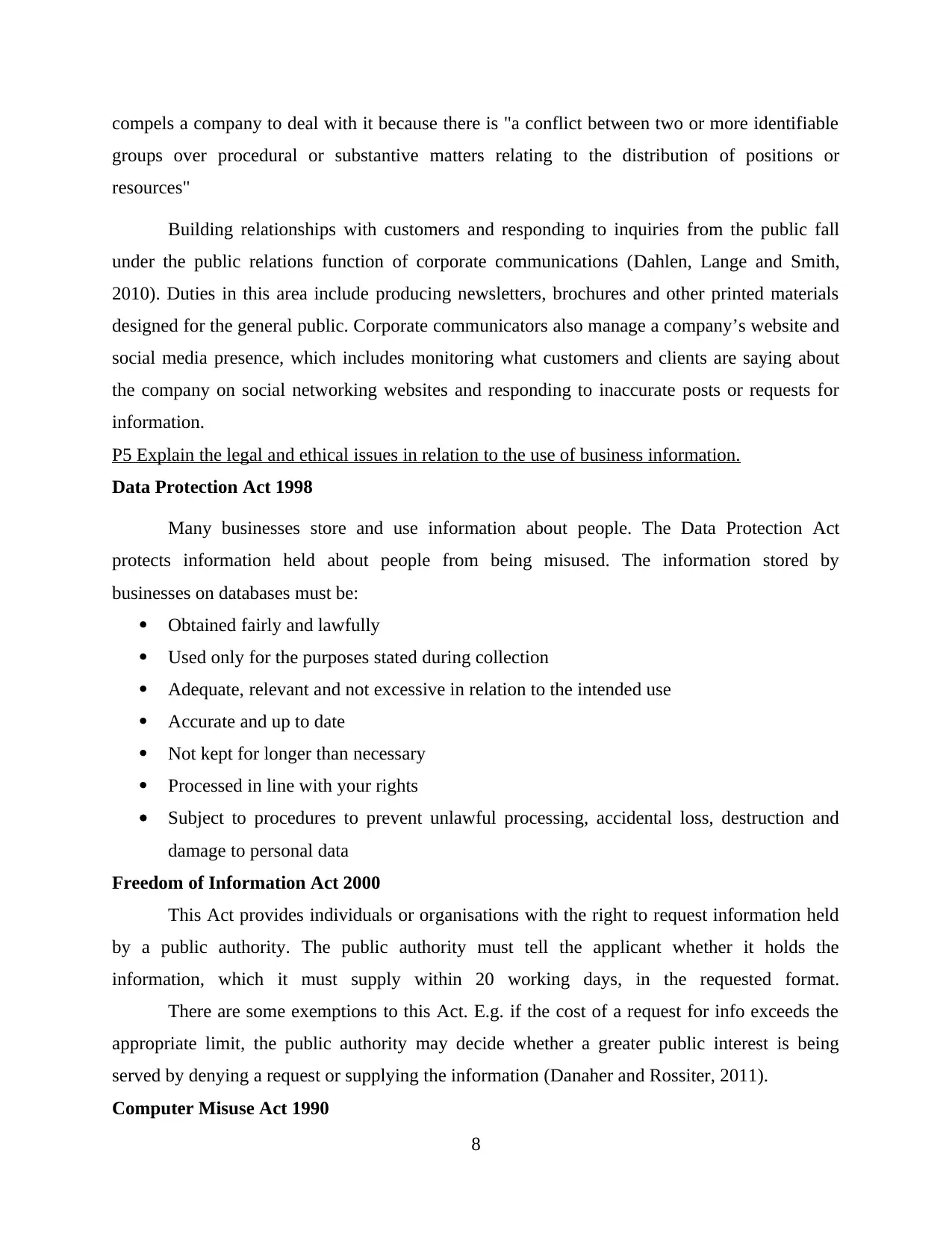
compels a company to deal with it because there is "a conflict between two or more identifiable
groups over procedural or substantive matters relating to the distribution of positions or
resources"
Building relationships with customers and responding to inquiries from the public fall
under the public relations function of corporate communications (Dahlen, Lange and Smith,
2010). Duties in this area include producing newsletters, brochures and other printed materials
designed for the general public. Corporate communicators also manage a company’s website and
social media presence, which includes monitoring what customers and clients are saying about
the company on social networking websites and responding to inaccurate posts or requests for
information.
P5 Explain the legal and ethical issues in relation to the use of business information.
Data Protection Act 1998
Many businesses store and use information about people. The Data Protection Act
protects information held about people from being misused. The information stored by
businesses on databases must be:
Obtained fairly and lawfully
Used only for the purposes stated during collection
Adequate, relevant and not excessive in relation to the intended use
Accurate and up to date
Not kept for longer than necessary
Processed in line with your rights
Subject to procedures to prevent unlawful processing, accidental loss, destruction and
damage to personal data
Freedom of Information Act 2000
This Act provides individuals or organisations with the right to request information held
by a public authority. The public authority must tell the applicant whether it holds the
information, which it must supply within 20 working days, in the requested format.
There are some exemptions to this Act. E.g. if the cost of a request for info exceeds the
appropriate limit, the public authority may decide whether a greater public interest is being
served by denying a request or supplying the information (Danaher and Rossiter, 2011).
Computer Misuse Act 1990
8
groups over procedural or substantive matters relating to the distribution of positions or
resources"
Building relationships with customers and responding to inquiries from the public fall
under the public relations function of corporate communications (Dahlen, Lange and Smith,
2010). Duties in this area include producing newsletters, brochures and other printed materials
designed for the general public. Corporate communicators also manage a company’s website and
social media presence, which includes monitoring what customers and clients are saying about
the company on social networking websites and responding to inaccurate posts or requests for
information.
P5 Explain the legal and ethical issues in relation to the use of business information.
Data Protection Act 1998
Many businesses store and use information about people. The Data Protection Act
protects information held about people from being misused. The information stored by
businesses on databases must be:
Obtained fairly and lawfully
Used only for the purposes stated during collection
Adequate, relevant and not excessive in relation to the intended use
Accurate and up to date
Not kept for longer than necessary
Processed in line with your rights
Subject to procedures to prevent unlawful processing, accidental loss, destruction and
damage to personal data
Freedom of Information Act 2000
This Act provides individuals or organisations with the right to request information held
by a public authority. The public authority must tell the applicant whether it holds the
information, which it must supply within 20 working days, in the requested format.
There are some exemptions to this Act. E.g. if the cost of a request for info exceeds the
appropriate limit, the public authority may decide whether a greater public interest is being
served by denying a request or supplying the information (Danaher and Rossiter, 2011).
Computer Misuse Act 1990
8
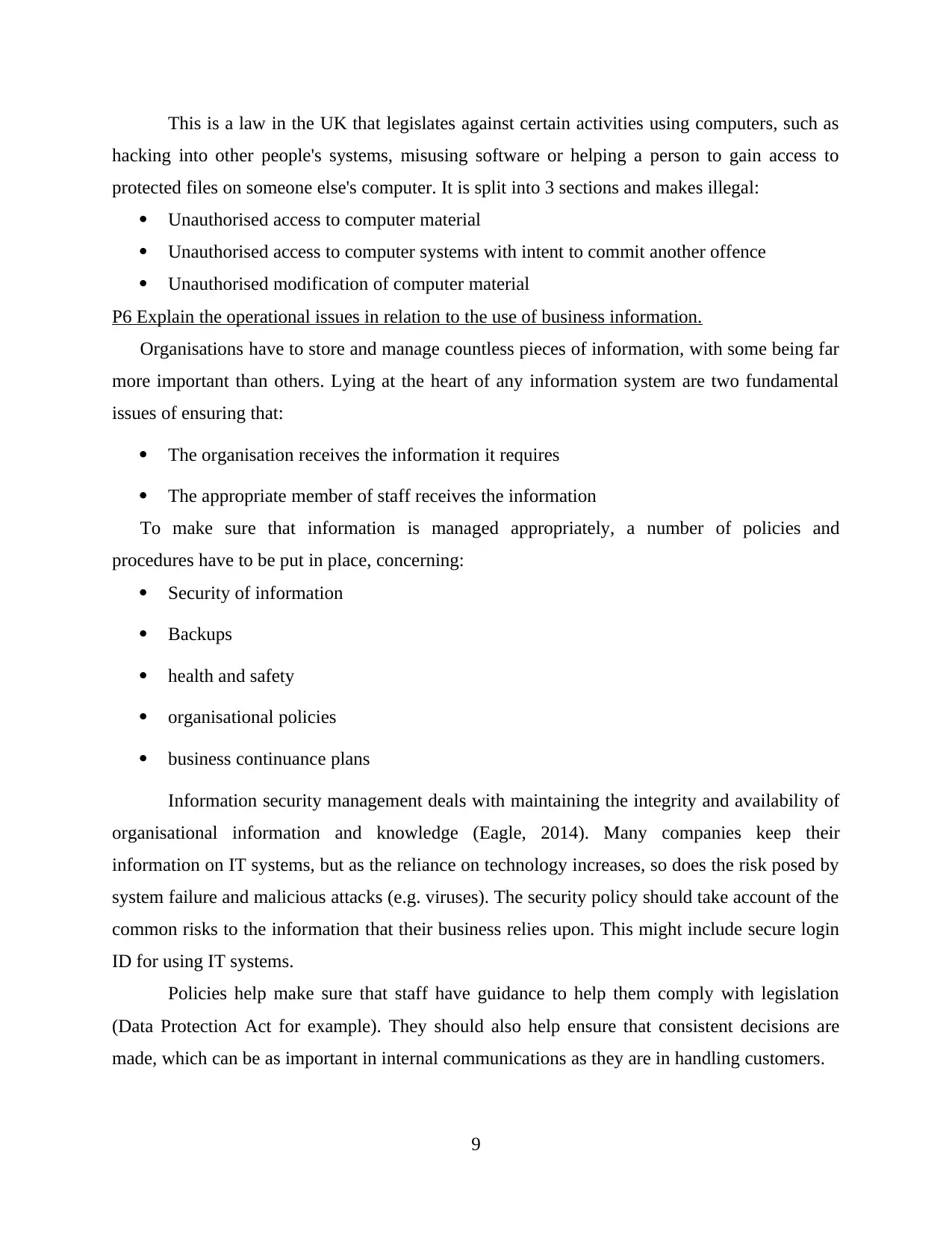
This is a law in the UK that legislates against certain activities using computers, such as
hacking into other people's systems, misusing software or helping a person to gain access to
protected files on someone else's computer. It is split into 3 sections and makes illegal:
Unauthorised access to computer material
Unauthorised access to computer systems with intent to commit another offence
Unauthorised modification of computer material
P6 Explain the operational issues in relation to the use of business information.
Organisations have to store and manage countless pieces of information, with some being far
more important than others. Lying at the heart of any information system are two fundamental
issues of ensuring that:
The organisation receives the information it requires
The appropriate member of staff receives the information
To make sure that information is managed appropriately, a number of policies and
procedures have to be put in place, concerning:
Security of information
Backups
health and safety
organisational policies
business continuance plans
Information security management deals with maintaining the integrity and availability of
organisational information and knowledge (Eagle, 2014). Many companies keep their
information on IT systems, but as the reliance on technology increases, so does the risk posed by
system failure and malicious attacks (e.g. viruses). The security policy should take account of the
common risks to the information that their business relies upon. This might include secure login
ID for using IT systems.
Policies help make sure that staff have guidance to help them comply with legislation
(Data Protection Act for example). They should also help ensure that consistent decisions are
made, which can be as important in internal communications as they are in handling customers.
9
hacking into other people's systems, misusing software or helping a person to gain access to
protected files on someone else's computer. It is split into 3 sections and makes illegal:
Unauthorised access to computer material
Unauthorised access to computer systems with intent to commit another offence
Unauthorised modification of computer material
P6 Explain the operational issues in relation to the use of business information.
Organisations have to store and manage countless pieces of information, with some being far
more important than others. Lying at the heart of any information system are two fundamental
issues of ensuring that:
The organisation receives the information it requires
The appropriate member of staff receives the information
To make sure that information is managed appropriately, a number of policies and
procedures have to be put in place, concerning:
Security of information
Backups
health and safety
organisational policies
business continuance plans
Information security management deals with maintaining the integrity and availability of
organisational information and knowledge (Eagle, 2014). Many companies keep their
information on IT systems, but as the reliance on technology increases, so does the risk posed by
system failure and malicious attacks (e.g. viruses). The security policy should take account of the
common risks to the information that their business relies upon. This might include secure login
ID for using IT systems.
Policies help make sure that staff have guidance to help them comply with legislation
(Data Protection Act for example). They should also help ensure that consistent decisions are
made, which can be as important in internal communications as they are in handling customers.
9
⊘ This is a preview!⊘
Do you want full access?
Subscribe today to unlock all pages.

Trusted by 1+ million students worldwide
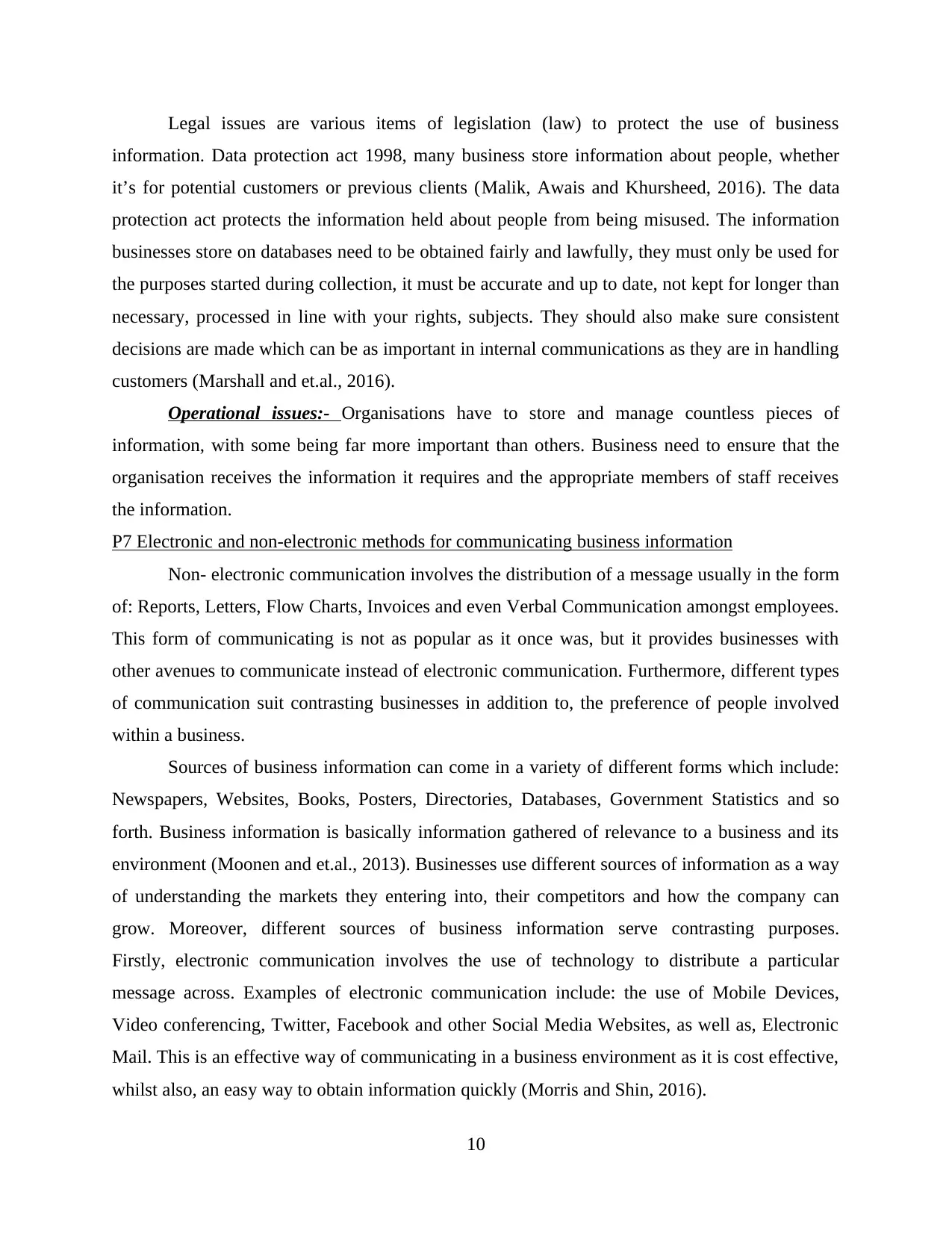
Legal issues are various items of legislation (law) to protect the use of business
information. Data protection act 1998, many business store information about people, whether
it’s for potential customers or previous clients (Malik, Awais and Khursheed, 2016). The data
protection act protects the information held about people from being misused. The information
businesses store on databases need to be obtained fairly and lawfully, they must only be used for
the purposes started during collection, it must be accurate and up to date, not kept for longer than
necessary, processed in line with your rights, subjects. They should also make sure consistent
decisions are made which can be as important in internal communications as they are in handling
customers (Marshall and et.al., 2016).
Operational issues:- Organisations have to store and manage countless pieces of
information, with some being far more important than others. Business need to ensure that the
organisation receives the information it requires and the appropriate members of staff receives
the information.
P7 Electronic and non-electronic methods for communicating business information
Non- electronic communication involves the distribution of a message usually in the form
of: Reports, Letters, Flow Charts, Invoices and even Verbal Communication amongst employees.
This form of communicating is not as popular as it once was, but it provides businesses with
other avenues to communicate instead of electronic communication. Furthermore, different types
of communication suit contrasting businesses in addition to, the preference of people involved
within a business.
Sources of business information can come in a variety of different forms which include:
Newspapers, Websites, Books, Posters, Directories, Databases, Government Statistics and so
forth. Business information is basically information gathered of relevance to a business and its
environment (Moonen and et.al., 2013). Businesses use different sources of information as a way
of understanding the markets they entering into, their competitors and how the company can
grow. Moreover, different sources of business information serve contrasting purposes.
Firstly, electronic communication involves the use of technology to distribute a particular
message across. Examples of electronic communication include: the use of Mobile Devices,
Video conferencing, Twitter, Facebook and other Social Media Websites, as well as, Electronic
Mail. This is an effective way of communicating in a business environment as it is cost effective,
whilst also, an easy way to obtain information quickly (Morris and Shin, 2016).
10
information. Data protection act 1998, many business store information about people, whether
it’s for potential customers or previous clients (Malik, Awais and Khursheed, 2016). The data
protection act protects the information held about people from being misused. The information
businesses store on databases need to be obtained fairly and lawfully, they must only be used for
the purposes started during collection, it must be accurate and up to date, not kept for longer than
necessary, processed in line with your rights, subjects. They should also make sure consistent
decisions are made which can be as important in internal communications as they are in handling
customers (Marshall and et.al., 2016).
Operational issues:- Organisations have to store and manage countless pieces of
information, with some being far more important than others. Business need to ensure that the
organisation receives the information it requires and the appropriate members of staff receives
the information.
P7 Electronic and non-electronic methods for communicating business information
Non- electronic communication involves the distribution of a message usually in the form
of: Reports, Letters, Flow Charts, Invoices and even Verbal Communication amongst employees.
This form of communicating is not as popular as it once was, but it provides businesses with
other avenues to communicate instead of electronic communication. Furthermore, different types
of communication suit contrasting businesses in addition to, the preference of people involved
within a business.
Sources of business information can come in a variety of different forms which include:
Newspapers, Websites, Books, Posters, Directories, Databases, Government Statistics and so
forth. Business information is basically information gathered of relevance to a business and its
environment (Moonen and et.al., 2013). Businesses use different sources of information as a way
of understanding the markets they entering into, their competitors and how the company can
grow. Moreover, different sources of business information serve contrasting purposes.
Firstly, electronic communication involves the use of technology to distribute a particular
message across. Examples of electronic communication include: the use of Mobile Devices,
Video conferencing, Twitter, Facebook and other Social Media Websites, as well as, Electronic
Mail. This is an effective way of communicating in a business environment as it is cost effective,
whilst also, an easy way to obtain information quickly (Morris and Shin, 2016).
10
Paraphrase This Document
Need a fresh take? Get an instant paraphrase of this document with our AI Paraphraser
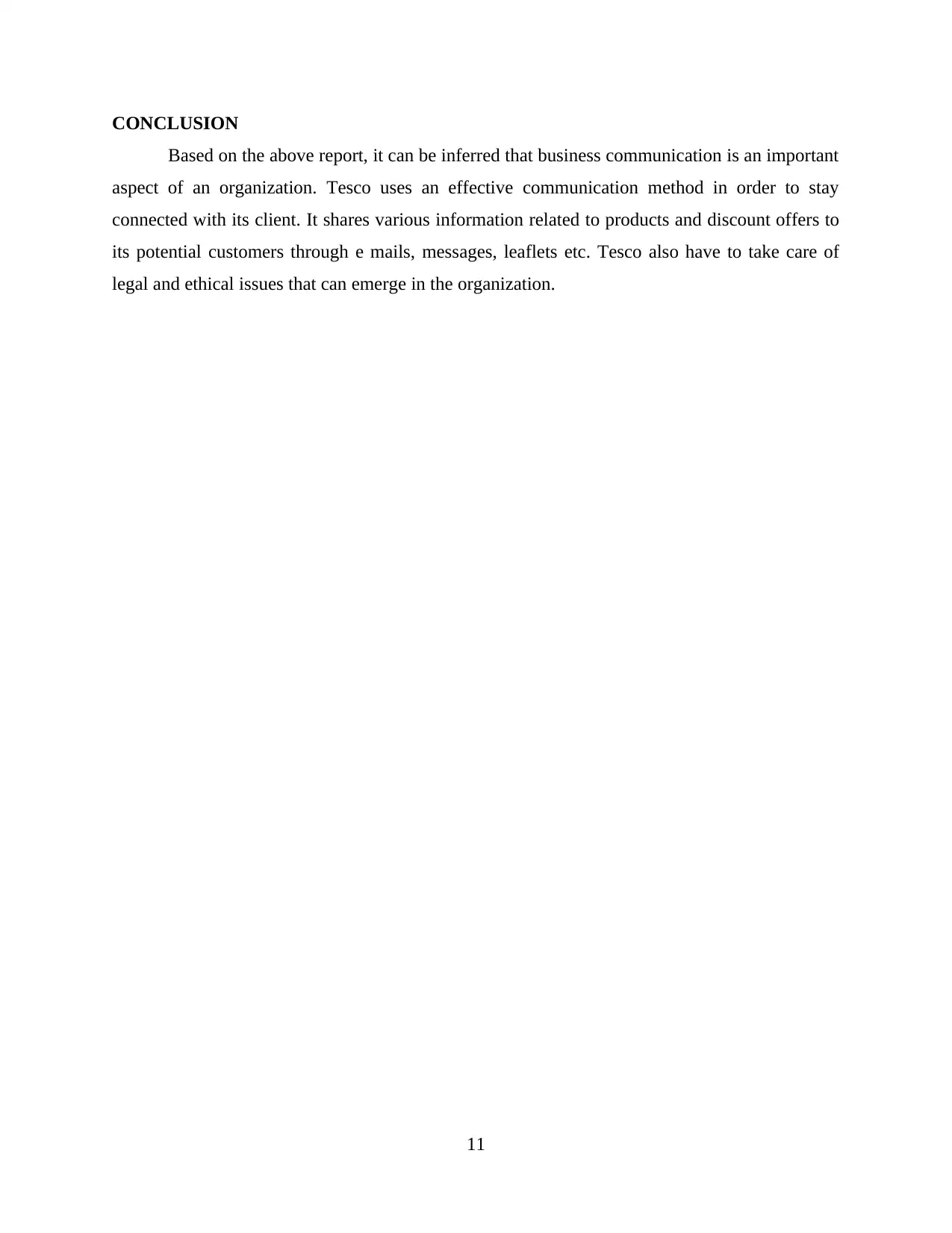
CONCLUSION
Based on the above report, it can be inferred that business communication is an important
aspect of an organization. Tesco uses an effective communication method in order to stay
connected with its client. It shares various information related to products and discount offers to
its potential customers through e mails, messages, leaflets etc. Tesco also have to take care of
legal and ethical issues that can emerge in the organization.
11
Based on the above report, it can be inferred that business communication is an important
aspect of an organization. Tesco uses an effective communication method in order to stay
connected with its client. It shares various information related to products and discount offers to
its potential customers through e mails, messages, leaflets etc. Tesco also have to take care of
legal and ethical issues that can emerge in the organization.
11

REFERENCES
Books and Journals
Alna S., Haccoun R. and Belcount M., 2010. Managing Performance Through Training and
Development. Cengage Learning publises.
Andrews, G. and Russell, M., 2012. Employability skills development: strategy, evaluation and
impact. Higher Education, Skills and Work-based Learning. 2(1). pp.33-44.
Ang, L., 2014. Integrated Marketing Communications A focus on new technologies and
advanced theories. Cambridge University Press.
Arendt, S. and Brettel, M., 2010. Understanding the influence of corporate social responsibility
on corporate identity, image, and firm performance. Management Decision. 48(10).
pp.1469 – 1492
Brewster, D. S., 2005. Communication. Warringal Publications.
Buciuniene, I. and Kazlauskaite, R., 2012. The linkage between HRM, CSR and performance
outcomes. Baltic Journal of Management. 7(1). pp.5-24.
Cerne, A., 2012. Market Communication as Socio-Political Activity in Emerging Markets
Business Society and Politics. International Business and Management. 28. pp.85 – 103
Chitty,W. and et.al., 2011. Integrated Marketing Communications. Cengage Learning.
Clutterbuck, D., 2011. The communicating company. Journal of Communication Management.
6(1). pp.70-76.
Cochoy, F., 2014. The American Marketing Association: A handrail for marketers and marketing
history. Journal of Historical Research in Marketing. 6(4). pp.538 – 547
Dahlen, M., Lange, F. and Smith, T., 2010. Marketing Communications: A Brand Narrative
Approach. John Wiley and Sons.
Danaher, P. and Rossiter, P., 2011. Comparing perceptions of marketing communication
channels. European Journal of Marketing. 45(12). pp.6 - 42
Eagle, L., 2014.Marketing Communications. Routledge.
Malik, M.S., Awais, M. and Khursheed, A., 2016. Impact of Liquidity on Profitability: A
Comprehensive Case of Pakistan’s Private Banking Sector. International Journal of
Economics and Finance. 8(3). pp.61-69.
12
Books and Journals
Alna S., Haccoun R. and Belcount M., 2010. Managing Performance Through Training and
Development. Cengage Learning publises.
Andrews, G. and Russell, M., 2012. Employability skills development: strategy, evaluation and
impact. Higher Education, Skills and Work-based Learning. 2(1). pp.33-44.
Ang, L., 2014. Integrated Marketing Communications A focus on new technologies and
advanced theories. Cambridge University Press.
Arendt, S. and Brettel, M., 2010. Understanding the influence of corporate social responsibility
on corporate identity, image, and firm performance. Management Decision. 48(10).
pp.1469 – 1492
Brewster, D. S., 2005. Communication. Warringal Publications.
Buciuniene, I. and Kazlauskaite, R., 2012. The linkage between HRM, CSR and performance
outcomes. Baltic Journal of Management. 7(1). pp.5-24.
Cerne, A., 2012. Market Communication as Socio-Political Activity in Emerging Markets
Business Society and Politics. International Business and Management. 28. pp.85 – 103
Chitty,W. and et.al., 2011. Integrated Marketing Communications. Cengage Learning.
Clutterbuck, D., 2011. The communicating company. Journal of Communication Management.
6(1). pp.70-76.
Cochoy, F., 2014. The American Marketing Association: A handrail for marketers and marketing
history. Journal of Historical Research in Marketing. 6(4). pp.538 – 547
Dahlen, M., Lange, F. and Smith, T., 2010. Marketing Communications: A Brand Narrative
Approach. John Wiley and Sons.
Danaher, P. and Rossiter, P., 2011. Comparing perceptions of marketing communication
channels. European Journal of Marketing. 45(12). pp.6 - 42
Eagle, L., 2014.Marketing Communications. Routledge.
Malik, M.S., Awais, M. and Khursheed, A., 2016. Impact of Liquidity on Profitability: A
Comprehensive Case of Pakistan’s Private Banking Sector. International Journal of
Economics and Finance. 8(3). pp.61-69.
12
⊘ This is a preview!⊘
Do you want full access?
Subscribe today to unlock all pages.

Trusted by 1+ million students worldwide
1 out of 13
Related Documents
Your All-in-One AI-Powered Toolkit for Academic Success.
+13062052269
info@desklib.com
Available 24*7 on WhatsApp / Email
![[object Object]](/_next/static/media/star-bottom.7253800d.svg)
Unlock your academic potential
Copyright © 2020–2025 A2Z Services. All Rights Reserved. Developed and managed by ZUCOL.





